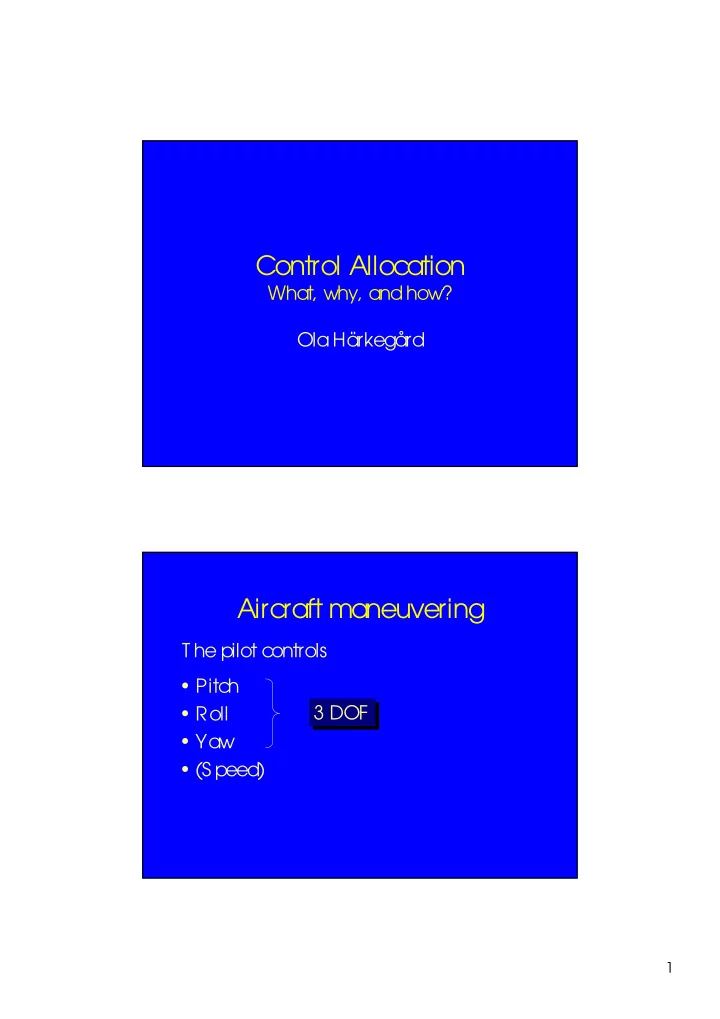

Control Allocation What, why, and how? Ola Härkegård Aircraft maneuvering T he pilot controls • Pitc h 3 DOF • Roll 3 DOF • Yaw • (S peed) 1
T raditional configuration Modern configuration Rudder Canard wings L eading edge flaps T railing edge flaps 2
Control allocation How do we distribute the c ontrol action How do we distribute the c ontrol action � among a redundant set of actuators? among a redundant set of actuators? Modular control design • Aircraft dynamics: ~ ~ ( ) ( ( ) ) ( ) x = ≈ = f x , u f x , m x , u f x , v � dim ≈ 10 dim 3 1. Design v=k(x,r) for closed loop 1. Design v=k(x,r) for closed loop performance. performance. 2. S olve m(x,u) ≈ Bu=v for u. 3
Controller overview r v u Pre- S tate Control filter feedback alloc. x Why is modularity good? • Not all c ontrol designs methods handle redundancy. • S eparate control alloc ation simplifies actuator c onstraint handling. • If an ac tuator fails, only c ontrol reallocation is needed. 4
Practical considerations ... while solving Bu=v: • u is c onstrained in • Minimum-phase position and in rate. response. ≤ ≤ u u u • Want to minimize – drag • T he ac tuators have – radar signature limited bandwidth. – structural load • Ac tuators should not • We are in a hurry! c ounteract (50-100 Hz) eachother. S olutions = Bu v ≤ ≤ u u u • Optimization based approac hes • Direct control alloc ation • Daisy chaining 5
Daisy chaining 1. Use elevators 2. Use T VC for until they saturate. additional c ontrol. Direct control allocation v=Bu v u 6
Optimization based CA ( ) min f u u = Bu v ≤ ≤ u u u • How do we c hoose f(u)? • Can we solve the problem in real time? Pseudo-inverse T he optimal solution to min u 2 u = Bu v ( ) − 1 = = T T † is given by u B BB v B v ( ) − Extension: min W u u p 2 u 7
Half-time summary ( ) ( ( ) ) = S o far, static CA: u t h v t S ame relative control distribution regardless of situation: • maneuvering (transient) • trimmed flight (steady state) Dynamic control allocation • Explicit filtering: How c an we impose v LP u 1 = Bu v ? ≤ ≤ u u u u HP 2 Incorporate filtering into an Incorporate filtering into an optimization framework. optimization framework. 8
Main idea ( ( ) ( ) ) ( ( ) ( ) ) 2 2 − + − − min W u t u t W u t u t 1 1 s 2 2 2 u ( t ) ( ( ) ( ) ) 2 = − + W u t u 0 t � 2 = Bu v ≤ ≤ u u u • S tability? • Control distribution? T he non-saturated case ( ( ) ( ) ) ( ( ) ( ) ) 2 2 − + − − min W u t u t W u t u t 1 1 s 2 2 2 u ( t ) = Bu v is solved by ( ) ( ) ( ) ( ) = + − + u t Eu t Fu t 1 Gv t s 9
Is v → u stable? T hm: If W 1 is non-singular then all eigenvalues of F satisfy ( ) ≤ λ < 0 F 1 • Asymptotically stable. • Not oscillatory. S teady state distribution? T hm: If u s satisfies Bu s = v then ( ) = lim u t u s → ∞ t ( ) − min W u u s p u s u s c an be computed from = Bu v s 10
Design example • Mach 0.5, 1000 m • Pitc hing only – canards – elevons – T VC • T rimmed flight: elevons only • Canards: high frequencies • T VC: midrange frequenc ies Parameters [ ] u = = − − • Dynamics : v Bu 8 . 0 20 . 2 0 . 87 • Design variables : 0 1 0 0 1 0 0 = − = = u s 1 / 20 . 2 v W 0 1 0 W 0 10 0 1 2 0 0 0 0 . 1 0 0 2 11
Frequency distribution 0 10 —Canards Control effort distribution —Elevons -1 10 —T VC -2 10 -3 10 -4 10 -2 -1 0 1 2 10 10 10 10 10 Frequency (rad/sec) Aircraft response 5 25 q r 20 15 q [deg/s] u [deg] 10 0 5 —Canards —Elevons 0 —T VC -5 -5 0 2 4 6 8 0 2 4 6 8 time [s] time [s] 12
Computing the solution ( ) − min W u u 0 2 u ( ) 2 ∈ = − u arg min Bu W v Bu v a ≤ ≤ u u u Can this problem be solved in real-time? Not acc ording to the litterature. Problem specific info • S imple inequality bounds. • From t-1: – u – ac tive constraints • Convergence in one sample not necessary. T rim existing T rim existing methods! methods! 13
S ummary • Dynamic control allocation - a new conc ept. • Need for efficient solvers. • New field ⇒ lot’s to do! 14
Recommend
More recommend